March 11, 2020
Jerez enroute to Seville
22 hours of flights and airports, three movies, and over 4500 miles in the air, and we’re finally in Andalusia. Checking with my gps, however, discloses that we’re at the 37 th parallel, 3737 miles from home. And really out of touch with much news from the United States. I hadn’t realized that EU privacy laws, which changed last May, disabled most American news sources. I can get headlines, but when I click my usual sources–Trib/NYT/Wall Street Journal, and Pantagraph–I get a notice that they are banned from delivering content. And ESPN switches to the Spanish/European edition.
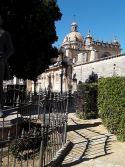
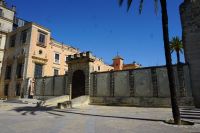 Perhaps it’s just as well that we are enjoying where we are, which seems far indeed. We left Jerez earlier today for Seville, having seen the three biggest sites in Jerez, a city of 200,000 that has its roots in Phoenician, Roman, Muslim, Spanish cultures and histories. The Phoenicians left nothing except stories about Hannibal and Carthage, and vineyards. The legacy was one of the main crops of al-Andalusia (named for the Muslim influence, which lasted from 711 until the 13 th century, when Alfonso the Wise, so-named because he knew at least three languages, which made him wise at the time, reconquered this part of Spain from the Muslims). The soil apparently is excellent for a white grape that lends itself to sherry, and on the hill that
Perhaps it’s just as well that we are enjoying where we are, which seems far indeed. We left Jerez earlier today for Seville, having seen the three biggest sites in Jerez, a city of 200,000 that has its roots in Phoenician, Roman, Muslim, Spanish cultures and histories. The Phoenicians left nothing except stories about Hannibal and Carthage, and vineyards. The legacy was one of the main crops of al-Andalusia (named for the Muslim influence, which lasted from 711 until the 13 th century, when Alfonso the Wise, so-named because he knew at least three languages, which made him wise at the time, reconquered this part of Spain from the Muslims). The soil apparently is excellent for a white grape that lends itself to sherry, and on the hill that 
 commands the city, one of the wine bodegas is Gonzalez Byass, makers of Tio Pepe, the largest selling brand, and the most visited vineyard in Spain.
commands the city, one of the wine bodegas is Gonzalez Byass, makers of Tio Pepe, the largest selling brand, and the most visited vineyard in Spain.
I did my part, touring the facility, which included sampling four varieties. Mr. Gonzalez was a banker turned wine-grower (at 23) who took on Mr. Byass, an English financier, as a partner, and the two families, now in the sixth generation, 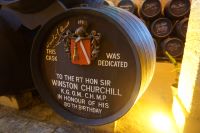 still run the company. It owns and sells a variety of wines around the globe, including Chilean, and some brandies. I was a little surprised to learn that sherries do not get packaged by year because it is a blended mixture, and can age up to 20 years—the older, the sweeter—like people, n’est ce pas?
still run the company. It owns and sells a variety of wines around the globe, including Chilean, and some brandies. I was a little surprised to learn that sherries do not get packaged by year because it is a blended mixture, and can age up to 20 years—the older, the sweeter—like people, n’est ce pas?
The second edifice on the hill that overlooks the city was the symbol of political power—the Alcazar. Apparently two Muslim dynasties ruled the 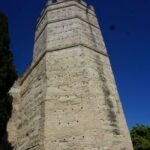 city, and each was responsible for establishing part of the Alcazar (if it starts with an al—it’s probably Islamic). The Alcazar was residence/fortress of th
city, and each was responsible for establishing part of the Alcazar (if it starts with an al—it’s probably Islamic). The Alcazar was residence/fortress of th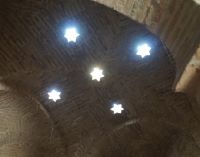 e rulers. Much of it is restored—the horseshoe archway, the three room baths—hot, cold, and ablution—with star-like holes in the dome to remind the Muslims of their desert heritage, a small mosque (that became a chapel), and square ramparts and towers that proved the best views of the town. There’s also a garden and some pools, along with orange trees whose fragrance fills the air. The Alcazar became the residence of the mayor, one of whom built an 18th century baroque palace within it that somehow works with the Muslim architecture.
e rulers. Much of it is restored—the horseshoe archway, the three room baths—hot, cold, and ablution—with star-like holes in the dome to remind the Muslims of their desert heritage, a small mosque (that became a chapel), and square ramparts and towers that proved the best views of the town. There’s also a garden and some pools, along with orange trees whose fragrance fills the air. The Alcazar became the residence of the mayor, one of whom built an 18th century baroque palace within it that somehow works with the Muslim architecture.
Across from the Alcazar, and built on the site of the Mosque (winners can do that) is the basilica, a huge cathedral in its second version. The tower from the first remained after (I think) an 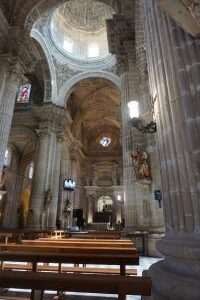
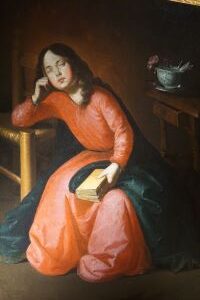 earthquake, and the rebuild was mostly gothic/baroque, two of my favorite church styles. Some of the altars and paintings came from convents and monasteries that were at one point or another confiscated. The main painting is a Zurbaran of a young Mary (late 16th century). When Pope John Paul II visited here in 1980, he elevated the cathedral to a basilica, meaning it’s the seat of the bishop.
earthquake, and the rebuild was mostly gothic/baroque, two of my favorite church styles. Some of the altars and paintings came from convents and monasteries that were at one point or another confiscated. The main painting is a Zurbaran of a young Mary (late 16th century). When Pope John Paul II visited here in 1980, he elevated the cathedral to a basilica, meaning it’s the seat of the bishop.
The three main sites were within easy walking distance from our hotel—enshrining religion, political power, and money at the time. We’re now in Seville, about 90 miles away, with another interesting story to tell, beginning with the name of our hotel, which is how I’ll start tomorrow night’s blog.